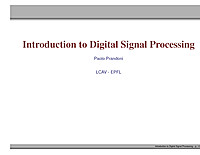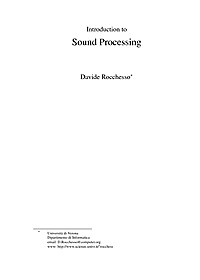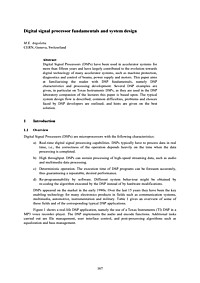
Digital Signal Processor Fundamentals and System Design
Digital Signal Processors (DSPs) have been used in accelerator systems for more than fifteen years and have largely contributed to the evolution towards digital technology of many accelerator systems, such as machine protection, diagnostics and control of beams, power supply and motors. This paper aims at familiarising the reader with DSP fundamentals, namely DSP characteristics and processing development. Several DSP examples are given, in particular on Texas Instruments DSPs, as they are used in the DSP laboratory companion of the lectures this paper is based upon. The typical system design flow is described; common difficulties, problems and choices faced by DSP developers are outlined; and hints are given on the best solution.
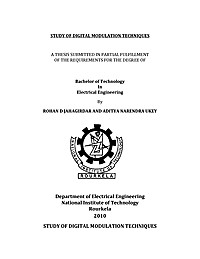
STUDY OF DIGITAL MODULATION TECHNIQUES
Modulation is the process of facilitating the transfer of information over a medium. Typically the objective of a digital communication system is to transport digital data between two or more nodes. In radio communications this is usually achieved by adjusting a physical characteristic of a sinusoidal carrier, either the frequency, phase, amplitude or a combination thereof . This is performed in real systems with a modulator at the transmitting end to impose the physical change to the carrier and a demodulator at the receiving end to detect the resultant modulation on reception. Hence, modulation can be objectively defined as the process of converting information so that it can be successfully sent through a medium. This thesis deals with the current digital modulation techniques used in industry. Also, the thesis examines the qualitative and quantitative criteria used in selection of one modulation technique over the other. All the experiments, and realted data collected were obtained using MATLAB and SIMULINK
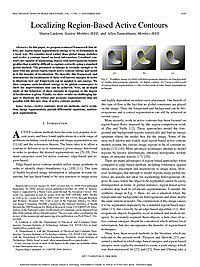
Region based Active Contour Segmentation
In this paper, we propose a natural framework that allows any region-based segmentation energy to be re-formulated in a local way. We consider local rather than global image statistics and evolve a contour based on local information. Localized contours are capable of segmenting objects with heterogeneous feature profiles that would be difficult to capture correctly using a standard global method. The presented technique is versatile enough to be used with any global region-based active contour energy and instill in it the benefits of localization. We describe this framework and demonstrate the localization of three well-known energies in order to illustrate how our framework can be applied to any energy. We then compare each localized energy to its global counterpart to show the improvements that can be achieved. Next, an in-depth study of the behaviors of these energies in response to the degree of localization is given. Finally, we show results on challenging images to illustrate the robust and accurate segmentations that are possible with this new class of active contour models.
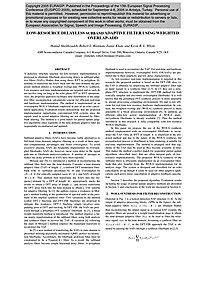
LOW-RESOURCE DELAYLESS SUBBAND ADAPTIVE FILTER USING WEIGHTED OVERLAP-ADD
A delayless structure targeted for low-resource implementation is proposed to eliminate filterbank processing delays in subband adaptive filters (SAFs). Rather than using direct IFFT or polyphase filterbanks to transform the SAFs back into the time-domain, the proposed method utilizes a weighted overlap-add (WOLA) synthesis. Low-resource real-time implementations are targeted and as such do not involve long (as long as the echo plant) FFT or IFFT operations. Also, the proposed approach facilitates time distribution of the adaptive filter reconstruction calculations crucial for efficient real-time and hardware implementation. The method is implemented on an oversampled WOLA filterbank employed as part of an echo cancellation application. Evaluation results demonstrate that the proposed implementation outperforms conventional SAF systems since the signals used in actual adaptive filtering are not distorted by filterbank aliasing. The method is a good match for partial update adaptive algorithms since segments of the time-domain adaptive filter are sequentially reconstructed and updated.
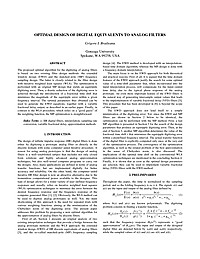
OPTIMAL DESIGN OF DIGITAL EQUIVALENTS TO ANALOG FILTERS
The proposed optimal algorithm for the digitizing of analog filters is based on two existing filter design methods: the extended window design (EWD) and the matched–pole (MP) frequency sampling design. The latter is closely related to the filter design with iterative weighted least squares (WLS). The optimization is performed with an original MP design that yields an equiripple digitizing error. Then, a drastic reduction of the digitizing error is achieved through the introduction of a fractional time shift that minimizes the magnitude of the equiripple error within a given frequency interval. The optimal parameters thus obtained can be used to generate the EWD equations, together with a variable fractional delay output, as described in an earlier paper. Finally, in contrast to the WLS procedure, which relies on a “good guess” of the weighting function, the MP optimization is straightforward.
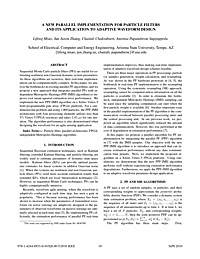
A NEW PARALLEL IMPLEMENTATION FOR PARTICLE FILTERS AND ITS APPLICATION TO ADAPTIVE WAVEFORM DESIGN
Sequential Monte Carlo particle filters (PFs) are useful for estimating nonlinear non-Gaussian dynamic system parameters. As these algorithms are recursive, their real-time implementation can be computationally complex. In this paper, we analyze the bottlenecks in existing parallel PF algorithms, and we propose a new approach that integrates parallel PFs with independent Metropolis-Hastings (PPF-IMH) algorithms to improve root mean-squared estimation error performance. We implement the new PPF-IMH algorithm on a Xilinx Virtex-5 field programmable gate array (FPGA) platform. For a onedimensional problem and using 1,000 particles, the PPF-IMH architecture with four processing elements utilizes less than 5% Virtex-5 FPGA resources and takes 5.85 μs for one iteration. The algorithm performance is also demonstrated when designing the waveform for an agile sensing application.
A pole-zero placement technique for designing second-order IIR parametric equalizer filters
A new procedure is presented for designing second-order parametric equalizer filters. In contrast to the traditional approach, in which the design is based on a bilinear transform of an analog filter, the presented procedure allows for designing the filter directly in the digital domain. A rather intuitive technique known as pole-zero placement, is treated here in a quantitative way. It is shown that by making some meaningful approximations, a set of relatively simple design equations can be obtained. Design examples of both notch and resonance filters are included to illustrate the performance of the proposed method, and to compare with state-of-the-art solutions.
Adaptive distributed noise reduction for speech enhancement in wireless acoustic sensor networks
An adaptive distributed noise reduction algorithm for speech enhancement is considered, which operates in a wireless acoustic sensor network where each node collects multiple microphone signals. In previous work, it was shown theoretically that for a stationary scenario, the algorithm provides the same signal estimators as the centralized multi-channel Wiener filter, while significantly compressing the data that is transmitted between the nodes. Here, we present simulation results of a fully adaptive implementation of the algorithm, in a non-stationary acoustic scenario with a moving speaker and two babble noise sources. The algorithm is implemented using a weighted overlap-add technique to reduce the overall input-output delay. It is demonstrated that good results can be obtained by estimating the required signal statistics with a long-term forgetting factor without downdating, even though the signal statistics change along with the iterative filter updates. It is also demonstrated that simultaneous node updating provides a significantly smoother and faster tracking performance compared to sequential node updating.
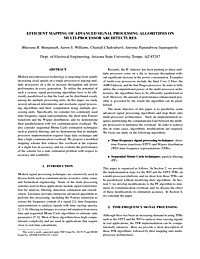
EFFICIENT MAPPING OF ADVANCED SIGNAL PROCESSING ALGORITHMS ON MULTI-PROCESSOR ARCHITECTURES
Modern microprocessor technology is migrating from simply increasing clock speeds on a single processor to placing multiple processors on a die to increase throughput and power performance in every generation. To utilize the potential of such a system, signal processing algorithms have to be efficiently parallelized so that the load can be distributed evenly among the multiple processing units. In this paper, we study several advanced deterministic and stochastic signal processing algorithms and their computation using multiple processing units. Specifically, we consider two commonly used time-frequency signal representations, the short-time Fourier transform and the Wigner distribution, and we demonstrate their parallelization with low communication overhead. We also consider sequential Monte Carlo estimation techniques such as particle filtering, and we demonstrate that its multiple processor implementation requires large data exchanges and thus a high communication overhead. We propose a modified mapping scheme that reduces this overhead at the expense of a slight loss in accuracy, and we evaluate the performance of the scheme for a state estimation problem with respect to accuracy and scalability.

Closing the gap: CPU and FPGA Trends in sustainable floating-point BLAS performance
Field programmable gate arrays (FPGAs) have long been an attractive alternative to microprocessors for computing tasks — as long as floating-point arithmetic is not required. Fueled by the advance of Moore’s Law, FPGAs are rapidly reaching sufficient densities to enhance peak floating-point performance as well. The question, however, is how much of this peak performance can be sustained. This paper examines three of the basic linear algebra subroutine (BLAS) functions: vector dot product, matrix-vector multiply, and matrix multiply. A comparison of microprocessors, FPGAs, and Reconfigurable Computing platforms is performed for each operation. The analysis highlights the amount of memory bandwidth and internal storage needed to sustain peak performance with FPGAs. This analysis considers the historical context of the last six years and is extrapolated for the next six years.
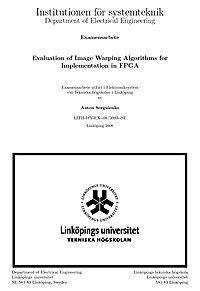
Evaluation of Image Warping Algorithms for Implementation in FPGA
The target of this master thesis is to evaluate the Image Warping technique and propose a possible design for an implementation in FPGA. The Image Warping is widely used in the image processing for image correction and rectification. A DSP is a usual choice for implantation of the image processing algorithms, but to decrease a cost of the target system it was proposed to use an FPGA for implementation. In this work a different Image Warping methods was evaluated in terms of performance, produced image quality, complexity and design size. Also, considering that it is not only Image Warping algorithm which will be implemented on the target system, it was important to estimate a possible memory bandwidth used by the proposed design. The evaluation was done by implemented a C-model of the proposed design with a finite datapath to simulate hardware implementation as close as possible.
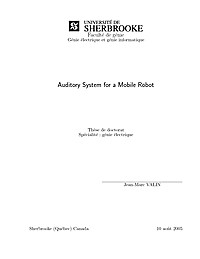
Auditory System for a Mobile Robot
The auditory system of living creatures provides useful information about the world, such as the location and interpretation of sound sources. For humans, it means to be able to focus one's attention on events, such as a phone ringing, a vehicle honking, a person taking, etc. For those who do not suffer from hearing impairments, it is hard to imagine a day without being able to hear, especially in a very dynamic and unpredictable world. Mobile robots would also benefit greatly from having auditory capabilities. In this thesis, we propose an artificial auditory system that gives a robot the ability to locate and track sounds, as well as to separate simultaneous sound sources and recognising simultaneous speech. We demonstrate that it is possible to implement these capabilities using an array of microphones, without trying to imitate the human auditory system. The sound source localisation and tracking algorithm uses a steered beamformer to locate sources, which are then tracked using a multi-source particle filter. Separation of simultaneous sound sources is achieved using a variant of the Geometric Source Separation (GSS) algorithm, combined with a multisource post-filter that further reduces noise, interference and reverberation. Speech recognition is performed on separated sources, either directly or by using Missing Feature Theory (MFT) to estimate the reliability of the speech features. The results obtained show that it is possible to track up to four simultaneous sound sources, even in noisy and reverberant environments. Real-time control of the robot following a sound source is also demonstrated. The sound source separation approach we propose is able to achieve a 13.7 dB improvement in signal-to-noise ratio compared to a single microphone when three speakers are present. In these conditions, the system demonstrates more than 80% accuracy on digit recognition, higher than most human listeners could obtain in our small case study when recognising only one of these sources. All these new capabilities will allow humans to interact more naturally with a mobile robot in real life settings.
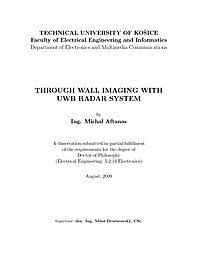
Through-Wall Imaging with UWB Radar System
Motivation: A man was interested in knowing of unknown from the very beginning of the human history. Our human eyes help us to investigate our environment by reflection of light. However, wavelengths of visible light allows transparent view through only a very small kinds of materials. On the other hand, Ultra WideBand (UWB) electromagnetic waves with frequencies of few Gigahertz are able to penetrate through almost all types of materials around us. With some sophisticated methods and a piece of luck we are able to investigate what is behind opaque walls. Rescue and security of the people is one of the most promising fields for such applications. Rescue: Imagine how useful can be information about interior of the barricaded building with terrorists and hostages inside for a policemen. The tactics of police raid can be build up on realtime information about ground plan of the room and positions of big objects inside. How useful for the firemen can be information about current interior state of the room before they get inside? Such hazardous environment, full of smoke with zero visibility, is very dangerous and each additional information can make the difference between life and death. Security: Investigating objects through plastic, rubber, dress or other nonmetallic materials could be highly useful as an additional tool to the existing x-ray scanners. Especially it could be used for scanning baggage at the airport, truckloads on borders, dangerous boxes, etc.
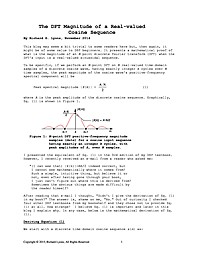
The DFT Magnitude of a Real-valued Cosine Sequence
This article may seem a bit trivial to some readers here but, then again, it might be of some value to DSP beginners. It presents a mathematical proof of what is the magnitude of an N-point discrete Fourier transform (DFT) when the DFT's input is a real-valued sinusoidal sequence.
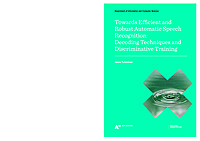
Towards Efficient and Robust Automatic Speech Recognition: Decoding Techniques and Discriminative Training
Automatic speech recognition has been widely studied and is already being applied in everyday use. Nevertheless, the recognition performance is still a bottleneck in many practical applications of large vocabulary continuous speech recognition. Either the recognition speed is not sufficient, or the errors in the recognition result limit the applications. This thesis studies two aspects of speech recognition, decoding and training of acoustic models, to improve speech recognition performance in different conditions.
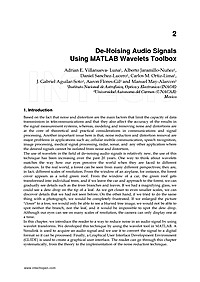
De-Noising Audio Signals Using MATLAB Wavelets Toolbox
Based on the fact that noise and distortion are the main factors that limit the capacity of data transmission in telecommunications and that they also affect the accuracy of the results in the signal measurement systems, whereas, modeling and removing noise and distortions are at the core of theoretical and practical considerations in communications and signal processing. Another important issue here is that, noise reduction and distortion removal are major problems in applications such as; cellular mobile communication, speech recognition, image processing, medical signal processing, radar, sonar, and any other application where the desired signals cannot be isolated from noise and distortion. The use of wavelets in the field of de-noising audio signals is relatively new, the use of this technique has been increasing over the past 20 years. One way to think about wavelets matches the way how our eyes perceive the world when they are faced to different distances. In the real world, a forest can be seen from many different perspectives; they are, in fact, different scales of resolution. From the window of an airplane, for instance, the forest cover appears as a solid green roof. From the window of a car, the green roof gets transformed into individual trees, and if we leave the car and approach to the forest, we can gradually see details such as the trees branches and leaves. If we had a magnifying glass, we could see a dew drop on the tip of a leaf. As we get closer to even smaller scales, we can discover details that we had not seen before. On the other hand, if we tried to do the same thing with a photograph, we would be completely frustrated. If we enlarged the picture "closer" to a tree, we would only be able to see a blurred tree image; we would not be able to spot neither the branch, nor the leaf, and it would be impossible to spot the dew drop. Although our eyes can see on many scales of resolution, the camera can only display one at a time. In this chapter, we introduce the reader to a way to reduce noise in an audio signal by using wavelet transforms. We developed this technique by using the wavelet tool in MATLAB. A Simulink is used to acquire an audio signal and we use it to convert the signal to a digital format so it can be processed. Finally, a Graphical User Interface Development Environment (GUIDE) is used to create a graphical user interface. The reader can go through this chapter systematically, from the theory to the implementation of the noise reduction technique. We will introduce in the first place the basic theory of an audio signal, the noise treatment fundamentals and principles of the wavelets theory. Then, we will present the development of noise reduction when using wavelet functions in MATLAB. In the foreground, we will demonstrate the usefulness of wavelets to reduce noise in a model system where Gaussian noise is inserted to an audio signal. In the following sections, we will present a practical example of noise reduction in a sinusoidal signal that has been generated in the MATLAB, which it is followed by an example with a real audio signal captured via Simulink. Finally, the graphic noise reduction model using GUIDE will be shown.
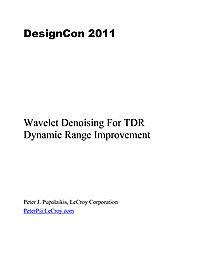
Wavelet Denoising for TDR Dynamic Range Improvement
A technique is presented for removing large amounts of noise present in time-domain-reflectometry (TDR) waveforms to increase the dynamic range of TDR waveforms and TDR based s-parameter measurements.
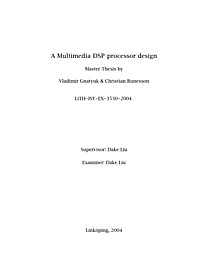
A Multimedia DSP processor design
This Master Thesis presents the design of the core of a fixed point general purpose multimedia DSP processor (MDSP) and its instruction set. This processor employs parallel processing techniques and specialized addressing models to speed up the processing of multimedia applications. The MDSP has a dual MAC structure with one enhanced MAC that provides a SIMD, Single Instruction Multiple Data, unit consisting of four parallel data paths that are optimized for accelerating multimedia applications. The SIMD unit performs four multimedia-oriented 16-bit operations every clock cycle. This accelerates computationally intensive procedures such as video and audio decoding. The MDSP uses a memory bank of four memories to provide multiple accesses of source data each clock cycle.








